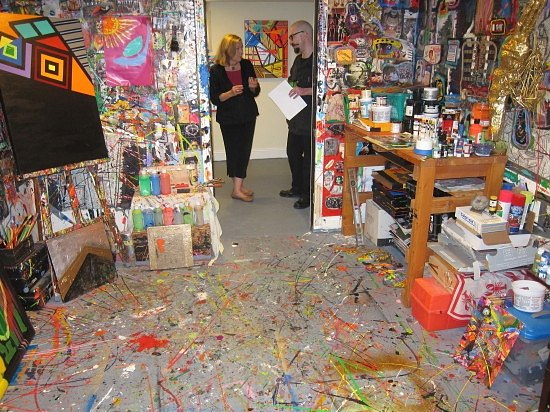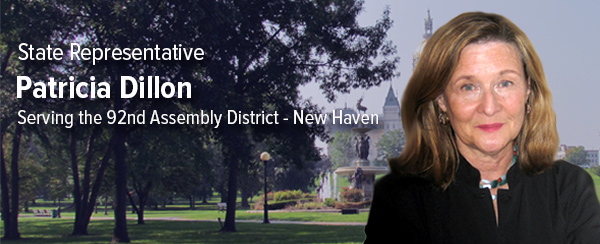
Rep. Dillon chatting with constituent Jacob Pongratz about his work. Photo by Allan Appel

October 8, 2012
DILLON VISITS WEST SIDE STUDIOS ON OPENING WEEKEND
OF CITYWIDE OPEN STUDIOS
by Allan Appel, New Haven Independent
Discovered on an opening-weekend “Open Studios” crawl: One artist who “sees” better when he blanks out the eyes of famous people collaged on his studio wall. Another who transforms pounds and pounds of old New Haven Registers back into trees. And a third who paints the Grand Avenue Bridge while channeling Cezanne and Van Gogh.

Rep. Dillon chatting with constituent Jacob Pongratz about his work. Photo by Allan Appel
Those discoveries came during a random journey around town into the sanctums of New Haven artists.
It was weekend one of the three-week annual artist extravaganza known as City-Wide Open Studios (CWOS). Its 15th (or crystal) anniversary kicked off its first of three weekends showcasing nearly 300 area artists.
Next weekend features artists who are in one single area, at Erector Square. Oct. 20-21 turns the recently vacated New Haven Register building into alternative play space for artists. This past Saturday and Sunday visitors got to see artists in their digs, whether a home studio or rented space. Click here for the official City-Wide Open Studios site with all the events. Click here for the map, including location and a sample work of all the artists opening their studios, including the ones mentioned in this article.
How to choose from among, alphabetically speaking, the fabric and paper artist Phillip Alexander to light artist Robert Zott? Or which neighborhoods to visit to check out the art among the dozens that dot our 20.51 square-mile village?
In keeping with the geometry theme of the crystal anniversary, the Independent visited four participating CWOS artists working or residing at the farthest points (more or less) in the north, south, east, and west of the city, according to CWOS printed materials. If you connect those four points on the route, you have a polygon, which certainly is the shape of the component structures in a crystal. Or some of them. Or maybe one of them.
Got it?
Never mind. Just come along for the ride.
Way out west is Jacob Pongratz‘s home studio on Judwin Avenue off Fountain. He’s been at the location for five years and painting for 15. The comfortable ranch home has a basement studio and gallery space combined; each has a radically different character. The studio has a floor reminiscent of of Jackson Pollock drip paintings, wild and free. Likewise, its walls are festooned with free form collages, doodles, and all kinds of occasional stuff; if you did this stuff to a college dorm room, the dean would send a bill home to your parents.
All this is strange for an artist who ultimately produces severely hard-edged if highly colorful work, like this two-part painting called “Potato Based Belief System.”
The answer, Pongratz revealed, is in the many crossed out eyes on most of the collaged faces, like Albert Einstein’s on the studio walls. He crosses them out as a reminder to divert “myself from the more human aspect of art and connect myself with the more ethereal,” he said.
Andrew Francis is in the north of town at studio space at 91 Shelton Ave. It’s the same complex where City Climb just opened up a climbing gym facility. Manager Matt Loter said the building, which houses at least a dozen artists, many Yale-connected, was formerly the Winchester Repeating Arms Company’s site to test ammunition.
Francis is a 2009 graduate of Cooper Union in New York and recent arrival in New Haven. His art is not about making loud noises, but there are some big statements lurking in the large fig leaf plaster sculptures that he lately has been creating from latex molds.
He spent a summer internship at the American Museum of Natural History in New York and is drawn to the infinite variety of the forms in the world, including, lately, fig leaves, peach pits, human jaws, and working up to whole human bodies. He dips the originals in latex, then pumps the mold full of plaster using a syringe. He repeats the process with each new generation getting larger.
In the case of the peach, “the idea is to get a pit to the size of the peach it came from. Then color it so it feels like peach and a pit at the same time.”
Hence a fig leaf that looks like a soft cozy pillow to one viewer, but not to Francis. He said he chose the leaf not only for its interesting venation (alas, they are less distinct with each new sculptural generation) but also because a fig leaf is what he said the Vatican ordered over all those Renaissance genitalia. As Francis put it, “a fig leaf spent too much time around private parts.”
Francis lives in East Rock. He chose the 91 Shelton space both for the cheap rent and because he can bike over from home in seven minutes. He plans include creating the full human body in latex; then he’ll suck the air out of it so that it shrivels up.
He won’t be showing that yet. To create it he’ll need to rent a larger studio. “It’s all about objects wanting to be other things,” he said.
Over in Fair Haven Heights lives another graduate of Cooper Union, Brian Gill Wendler. A bit older than Francis, Wendler has been working and exhibiting out of his home and studio on Clifton Street for 22 years. He now teaches at the Silvermine Academy of Art in New Canaan.
In his studio not far from one of his several images of the Grand Avenue Bridge is a collection of interviews of Paul Cezanne by journalists. “I could never make sense [of things Cezanne said about painting]. Now I do,” said Wendler.
Asked to explain, he added: “He talks a lot about recording sensations from nature. He talked about modulating colors to create form. There’s only one point on every object [Cezanne also said] that’s closest to you. And you paint back from there.”
Now, after all the years, Wendler says he gets Cezanne because he, unconsciously, is doing those same things in his work. He for example is not primarily interested in likeness. “You do achieve likeness but it’s through your own sensibilities and method. Cezanne was saying that a person shows through.”
“I’m concerned more with creating space than recording detail,” Wendler said of his landscapes. That’s why Cezanne didn’t mind a cloudy day, said Wendler.
The end of the tour led back south at 50 Orange St., Artspace itself. There Giada Crispiels is showing her installation of wire and paper vines as Artspace’s second artist-in-residence.
Crispiels is translated old copies of the New Haven Register into bushy trees and dandelion forms. She hopes to install them in the vacated Reg building that is CWOS’s alternative space on the Oct. 21 weekend.
In her studio, Crispiels, who arrived from Brescia, Italy, only two years ago, has made a wall of happy flowers growing on vines. They are created out of wire, masking tape, and old magazines and papers. On the floor the old copies of the Reg sprout as grass.
She said a friend called her not a recycler as an artist but an “upcycler,” creating something new out of the old.
“I love ivy. It’s very poetic, and so persistent, powerful, they are going to survive,” she said. “I’d like to cover one big building [in town] with it. But I’ll need help.”